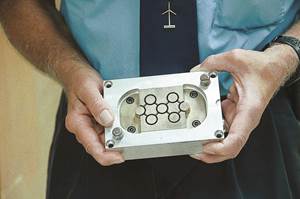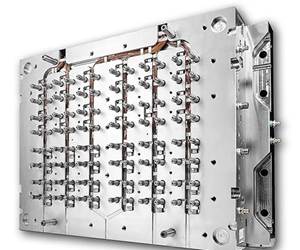Get a Grip on Screw Slippage
Screw slippage occurs when the screw in the barrel of the injection machine has difficulty picking up material from the feed throat or is unable to develop enough tack to convey the material down the length of the barrel.
Screw slippage occurs when the screw in the barrel of the injection machine has difficulty picking up material from the feed throat or is unable to develop enough tack to convey the material down the length of the barrel. Screw slippage can occur during the plasticating phase, when the screw rotates and moves back in the barrel to convey material along the screw and accumulate the next shot. If the screw begins to slip during plastication, the screw’s axial movement will stop while the screw continues to rotate. Screw slippage commonly results in material degradation before injection, part-quality issues such as short shots, and increased cycle times.
Causes of screw slippage can be traced to high backpressure, too-hot or too-cold rear barrel section, a worn barrel or screw, too-shallow feed section on the screw, improper hopper design, an empty or blocked hopper, wet resin, excessive lubricant in the resin, fines, or poorly cut resin or regrind.
PROCESS SETTINGS
A cold rear barrel zone is a often a main cause of screw slippage. There are three zones in the barrel of an injection molding machine. In the rear or feed zone, a thin film of molten polymer is created during heating and compression of the pellets. That melt film sticks to the barrel. Without this film, the pellets will not easily convey downstream.
Material in the feed zone must be heated to a critical temperature to generate that crucial melt film. Yet frequently the barrel residence time of the material is too short to allow the polymer to reach that temperature. This can occur because the job is being run on too small a machine with a correspondingly small barrel and screw. The short residence time causes incomplete melting and mixing of the molten polymer, and this in turn causes the screw to slip or stall.
Here are two easy ways to tell if this is happening. Check the melt temperature by purging a small amount of material from the end of the barrel. If the residence time is too short, the melt temperature will be below the barrel-temperature setpoints. Second, look at the molded parts: If there is any marbling or dark and light streaks, that shows the material was not mixed well enough in the barrel.
One solution to try if this occurs is to incrementally increase the temperature of the feed zone until the screw rotates and retracts consistently and without hesitation. You may have to raise the barrel temperatures higher than the recommended setpoints to reach this range.
High backpressure can also be a culprit in screw stalling or slippage. Raising the backpressure setting increases the amount of energy being put into the material. If the backpressure is set too high, the screw may not be able to generate enough forward conveying melt pressure to overcome the backpressure resistance. The screw will turn in place without retracting. This will put more work into the melt and can increase melt temperature significantly, which is a detriment to part quality and cycle time. The backpressure on the melt can be managed by controlling the valve on the injection cylinder.
HARDWARE PROBLEMS
If the cause of screw slippage is in the machine and not the process settings, screw and barrel wear is a likely culprit. As the resin melts in the transition zone of the screw it sticks to the barrel walls, just as it does in the feed zone. As the screw turns, it shears the material then wipes and conveys the material from the barrel walls toward the front of the screw. If there are areas of wear on the screw and barrel, the screw will not be as effective in moving the material downstream. If wear is suspected, the screw and barrel should be measured to check for the proper clearance between the two. The screw and barrel should be replaced or repaired if they are out of tolerance.
Screw design—specifically, the compression ratio (of the depth of the feed zone to the depth of the metering zone)—plays a vital role in plasticating consistency. A feed zone that is too shallow—resulting in a smaller compression ratio—will reduce output and can cause screw slippage due to starve feeding. Resin suppliers can recommend optimal compression ratios for their materials.
A malfunctioning check valve (non-return valve) can also cause screw slippage. As the screw is rotating and building a shot, the check ring should be in a forward (open) position, in contact with the ring retainer nose. If the check ring valve is in the rear (closed) position, or part way between the rear and forward seating positions, the melted polymer will have difficulty traveling through the gap between the check ring and the seat. If the check ring is the suspect it should be replaced immediately.
The resin feed hopper can be the source of several causes of screw slippage. Correct hopper design is critical to consistent feeding of material to the machine, but it is often overlooked. Square feed hoppers with a rapid compression zone (abrupt narrowing at the bottom) typically work well with uniformly sized virgin pellets. However, this is not the case when regrind is being added. Regrind particles can have a wide variety of shapes and sizes, which can hamper feeding consistency. Inconsistent feeding means the screw will not maintain uniform conveying pressure on the melt, and slippage can result. To solve this, try using a circular hopper with a gradual compression zone (more gradual taper at the bottom) in order to deal with the size differences between regrind and virgin pellets.
MATERIAL CONSISTENCY
As was just indicated, the shape and size of material particles affects feeding consistency. Poor pellet geometry can lead to poor screw processing and varying output as well as screw slippage. Pellets that are cut uniformly can be packed closer together in the feed zone of the screw. The tighter the pellets are packed together in the screw, the easier time the screw has in melting and conveying the material downstream. Poorly cut pellets will have a higher free volume (lower bulk density or more empty spaces between the pellets) and will not feed as easily, which can lead to screw slippage. Raising the rear temperature zone will begin the melting process sooner, and will allow for more melt compaction as the material flows downstream.
In the case of hygroscopic materials like nylon, wet resin can also be a source of screw slippage. Improperly dried material can reduce material viscosity significantly and generate water vapor in the barrel, making it hard for the screw to convey the material downstream. Use a moisture analyzer to determine the amount of moisture in the pellets at the bottom of the drying hopper and compare the readings with the material supplier’s recommendation for moisture content.
About the Author
Ralph Guyer is the marketing technical service coordinator for Solutia’s Nylon Plastics and Polymers Div. in St. Louis. He has more than 27 years’ experience in engineering design, injection molding, and product development.
Solution can be reached at (888) 927-2363 * www.vydyne.com. E-mail info@vydyne.com
Related Content
How to Select the Right Tool Steel for Mold Cavities
With cavity steel or alloy selection there are many variables that can dictate the best option.
Read MoreHow to Design Three-Plate Molds, Part 1
There are many things to consider, and paying attention to the details can help avoid machine downtime and higher maintenance costs, and keep the customer happy.
Read MoreInjection Molding: Focus on these Seven Areas to Set a Preventive Maintenance Schedule
Performing fundamental maintenance inspections frequently assures press longevity and process stability. Here’s a checklist to help you stay on top of seven key systems.
Read MoreHow to Optimize Pack & Hold Times for Hot-Runner & Valve-Gated Molds
Applying a scientific method to what is typically a trial-and-error process. Part 2 of 2.
Read MoreRead Next
For PLASTICS' CEO Seaholm, NPE to Shine Light on Sustainability Successes
With advocacy, communication and sustainability as three main pillars, Seaholm leads a trade association to NPE that ‘is more active today than we have ever been.’
Read MorePeople 4.0 – How to Get Buy-In from Your Staff for Industry 4.0 Systems
Implementing a production monitoring system as the foundation of a ‘smart factory’ is about integrating people with new technology as much as it is about integrating machines and computers. Here are tips from a company that has gone through the process.
Read MoreMaking the Circular Economy a Reality
Driven by brand owner demands and new worldwide legislation, the entire supply chain is working toward the shift to circularity, with some evidence the circular economy has already begun.
Read More














